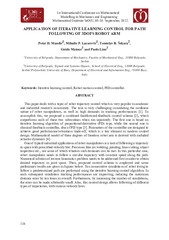Приказ основних података о документу
Application of iterative learning control for path following of 3DOFS robot arm
| dc.creator | Mandić, Petar | |
| dc.creator | Lazarević, Mihailo | |
| dc.creator | Šekara, Tomislav | |
| dc.creator | Maione, Guido | |
| dc.creator | Lino, Paolo | |
| dc.date.accessioned | 2023-01-28T16:24:25Z | |
| dc.date.available | 2023-01-28T16:24:25Z | |
| dc.date.issued | 2022 | |
| dc.identifier.isbn | 978-86-6060-127-0 | |
| dc.identifier.uri | https://machinery.mas.bg.ac.rs/handle/123456789/4079 | |
| dc.description.abstract | This paper deals with a topic of robot trajectory control which is very popular in academic and industrial research community. The task is very challenging considering the nonlinear nature of robot manipulators, as well as high demands in tracking performances [1]. To accomplish this, we proposed a combined feedforward-feedback control scheme [2], which outperforms each of these two subroutines when run separately. The first one is based on iterative learning algorithm of proportional-derivative (PD) type, while the second one is classical feedback controller, also of PD type [3]. Parameters of the controller are designed to achieve good performance/robustness trade-off, which is a key element in modern control design. Mathematical model of three degrees of freedom robot arm is derived with included actuator dynamics [4]. One of typical industrial applications of robot manipulators is a task of following a trajectory in space with prescribed velocity law. Processes like arc welding, painting, laser cutting, object inspection etc., are some of which wherein such demands can be met. In this particular case, robot manipulator needs to follow a circular trajectory with constant speed along the path. Numerical solution of inverse kinematics problem needs to be addressed first in order to obtain desired trajectory in joint space. Then, proposed control scheme is employed and some preliminary results are given in figures below. Ten consecutive simulations of robot trying to follow a predetermined path are performed using the iterative learning control algorithm. In each subsequent simulation tracking performances are improving, reducing the maximum distance error by ten times in overall. Furthermore, by increasing the number of simulations, the error can be made arbitrarily small. Also, this control design allows following of different types of trajectories, with various velocity laws. | sr |
| dc.language.iso | en | sr |
| dc.publisher | Univerzitet u Beogradu, Mašinski fakultet | sr |
| dc.relation | info:eu-repo/grantAgreement/MESTD/Technological Development (TD or TR)/33020/RS// | sr |
| dc.relation | info:eu-repo/grantAgreement/MESTD/inst-2020/200105/RS// | sr |
| dc.relation | Serbia-Italian bilateral project ADFOCMEDER | sr |
| dc.rights | openAccess | sr |
| dc.rights.uri | https://creativecommons.org/share-your-work/public-domain/cc0/ | |
| dc.source | Book of abstracts: 1st International Conference on Mathematical Modelling in Mechanics and Engineering Mathematical Institute SANU, 08-10. September, 2022. | sr |
| dc.subject | Iterative learning control | sr |
| dc.subject | Robot motion control | sr |
| dc.subject | PID controller | sr |
| dc.title | Application of iterative learning control for path following of 3DOFS robot arm | sr |
| dc.type | conferenceObject | sr |
| dc.rights.license | BY-NC-ND | sr |
| dc.citation.epage | 117 | |
| dc.citation.rank | M34 | |
| dc.citation.spage | 116 | |
| dc.identifier.fulltext | http://machinery.mas.bg.ac.rs/bitstream/id/9545/PMandic___ICME2022.pdf | |
| dc.identifier.rcub | https://hdl.handle.net/21.15107/rcub_machinery_4079 | |
| dc.type.version | publishedVersion | sr |


